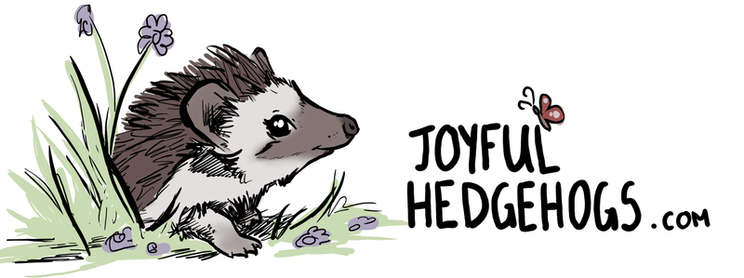- Pygmy Hedgehog Care -
When you first get your new hoglet or hedgehog home, he or she will be very stressed and most likely grumpy. I always recommend getting the hedgehog out and handling it for ten minutes or so before placing the hedgie in it’s new home and leaving it to settle. I find this speeds up the bonding process which is an essential part of owning a hedgehog. Naturally, hedgehogs have spines, and a frightened and unsociable hedgehog will curl into a ball and stick its spines out so that it is very prickly to hold. The hedgehog may also huff, pop and click, pushing the spines towards whatever is touching it. A happy, confident hedgehog will lay its spines flat and stay open (maybe balling up for a short time when first woken up) which is far easier to handle.
- Quilling -
When a hoglet reaches about twelve weeks old, it will start to go through quilling. This process can last a few days to a few months and can affect individual hedgehogs differently. Quilling is when the hedgehog sheds the baby spines and grows the new adult spines and can be very uncomfortable for a hedgehog.
Most hedgehogs will be more grumpy throughout this period and may suffer some dry skin which can be helped by an aveeno oil or oatmeal bath. To give an oatmeal bath, simply run warm water over oats in a pair of tights (or simular) until the water becomes cloudy. As bathing too often can make dry skin even worse, this should be done a maximum of once a week in severe cases during the quilling period. A little olive oil may be added to food to also help with dry skin or a one off use of pure Vitamin E oil.
It is very important to continue handling the hedgehog during this period to ensure that it does not become unsociable. It may be difficult, especially if the hedgie is having a hard time of the quilling and is feeling justifiably grumpy, but persistence is the key and you will be rewarded by a friendly hedgehog rather than a huffy one.
Most hedgehogs will be more grumpy throughout this period and may suffer some dry skin which can be helped by an aveeno oil or oatmeal bath. To give an oatmeal bath, simply run warm water over oats in a pair of tights (or simular) until the water becomes cloudy. As bathing too often can make dry skin even worse, this should be done a maximum of once a week in severe cases during the quilling period. A little olive oil may be added to food to also help with dry skin or a one off use of pure Vitamin E oil.
It is very important to continue handling the hedgehog during this period to ensure that it does not become unsociable. It may be difficult, especially if the hedgie is having a hard time of the quilling and is feeling justifiably grumpy, but persistence is the key and you will be rewarded by a friendly hedgehog rather than a huffy one.
- Diet -
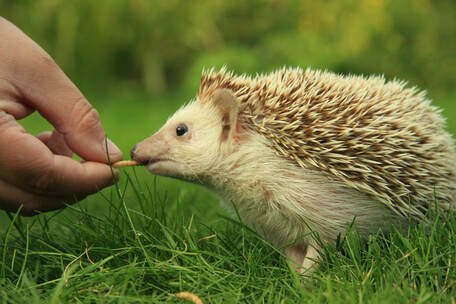
Hedgehogs can be prone to obesity which can have health complications, so the correct diet for your hedgehog is essential
A mix of cat biscuits with protein levels around 30% and a fat ratio no higher than 10% are the staple and should be freely available. Turkey or chicken based food flavours seem to go down the best with hedgehogs and fish flavoured foods should be avoided. A mix of biscuits is better as you can mix and match to get the right balance, it is more interesting for the hedgehog and also saves trouble if one of the foods is ever discontinued. Wild European hedgehog food is not suitable for Pygmy hedgehogs as some contain nuts and berries which are a choking hazard as well as having different nutritional values.
Hedgehogs enjoy some kind of insects in their diet which can be either live or dried (I feed both). Locusts, calci worms, waxworms and roaches are all favourite treats of my hoggies but waxworms are very fatty so should be fed as a treat only. I mainly feed dubia roaches and calci worms, with others relegated to occasional treat status. I prefer to feed live as, shortly before feeding they can be gut loaded (fed veg or fruit) which increases their nutritional value. Mealworms can be given only sparingly as a rare treat due to links to MBD when over-fed.
About 3 times a week I also supplement their diet with unseasoned cooked meats, egg, fruit or vegetables (cooked, raw or parboiled depending of veg)
A mix of cat biscuits with protein levels around 30% and a fat ratio no higher than 10% are the staple and should be freely available. Turkey or chicken based food flavours seem to go down the best with hedgehogs and fish flavoured foods should be avoided. A mix of biscuits is better as you can mix and match to get the right balance, it is more interesting for the hedgehog and also saves trouble if one of the foods is ever discontinued. Wild European hedgehog food is not suitable for Pygmy hedgehogs as some contain nuts and berries which are a choking hazard as well as having different nutritional values.
Hedgehogs enjoy some kind of insects in their diet which can be either live or dried (I feed both). Locusts, calci worms, waxworms and roaches are all favourite treats of my hoggies but waxworms are very fatty so should be fed as a treat only. I mainly feed dubia roaches and calci worms, with others relegated to occasional treat status. I prefer to feed live as, shortly before feeding they can be gut loaded (fed veg or fruit) which increases their nutritional value. Mealworms can be given only sparingly as a rare treat due to links to MBD when over-fed.
About 3 times a week I also supplement their diet with unseasoned cooked meats, egg, fruit or vegetables (cooked, raw or parboiled depending of veg)
|
Good Food Examples
|
Bad / Toxic Foods
|
Naturally your hedgehog will need fresh water every day in a heavy or untippable bowl. Water bottles are not recommended as a hedgehog can chip it’s teeth or trap it’s tongue. It also has a bad position for the hedgehog to drink from.
- Housing -
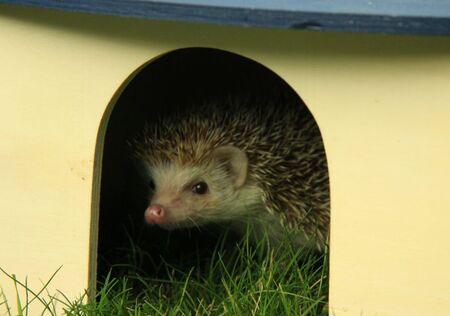
Hedgehogs are solitary animals so should be housed singly. Males in particular will fight to the death or inflict terrible injuries on each other. A male and female will continuously breed and often kill the babies or fight. Some females can cohabit but must be carefully monitored for any signs of aggression as fighting hedgehogs can cause a lot of damage. If two females are together it is best to make sure there are two wheels and separate sleeping areas to minimise the risk of conflict.
Hedgehogs can travel miles every night, so need a large size enclosure. I would say a bare minimum of four square feet. They will make use of all the space available. Height is not as important but will need to be tall enough to accommodate a 12” exercise wheel.
There are several types of enclosure which work well for a hedgehog which have advantages and disadvantages.
Hedgehogs can travel miles every night, so need a large size enclosure. I would say a bare minimum of four square feet. They will make use of all the space available. Height is not as important but will need to be tall enough to accommodate a 12” exercise wheel.
There are several types of enclosure which work well for a hedgehog which have advantages and disadvantages.
|
Vivarium
Advantages
|
Zoozone 2
Advantages
|
C & C Enclosures
Advantages
|
I use vivariums which are 4ft long and have extra vents to ensure there is enough ventilation and the inside does not become damp. These are stackable and look nicest but are heavy to move, can be more difficult to clean and can also be expensive if custom made. C & C cages can be used, which are cheaper and easier to clean, but, if they have bars, they will need to be blocked from the hedgehog’s access as hedgies can climb but are not very good at getting down so may fall trapping limbs and causing injuries.
- Substrate -
Fleece liners, Finacard, Megazorb, Carefresh, and newspaper can all be used as bedding for a hedgehog. (Or you can try a bio-active enclosure!)
Fleece liners work out fairly cheap as they can be reused. They can simply be washed when dirty but they do not allow the hedgehog to forage or dig around. Newspaper is similar but cannot be reused and will not absorb any poop/wee from the hedgie. Finacard and megazorb contain smells well and allow the hedgehog to root around.
I use megazorb for my hedgies. I found that it is absorbent and contains odours well. A loose substrate also allows a hedgehog to forage and I can hide treats, such as dried mealworms which most of the hedgehogs love digging out and munching. The only downside is it gets everywhere!
Fleece liners work out fairly cheap as they can be reused. They can simply be washed when dirty but they do not allow the hedgehog to forage or dig around. Newspaper is similar but cannot be reused and will not absorb any poop/wee from the hedgie. Finacard and megazorb contain smells well and allow the hedgehog to root around.
I use megazorb for my hedgies. I found that it is absorbent and contains odours well. A loose substrate also allows a hedgehog to forage and I can hide treats, such as dried mealworms which most of the hedgehogs love digging out and munching. The only downside is it gets everywhere!
- Cleaning -
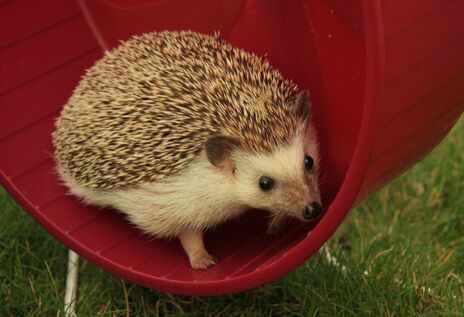
I clean my hedgehogs once a week with a spot clean every day. Most of my hedgehogs are litter trained but most poop will end up on the wheel as they will generally poop as they run. I only have one hedgehog who gets off the wheel to use the toilet. I find that standing the wheel in the litter tray means any stray poop ends up in the tray. Some hedgehogs will not litter train and these are the ones who need the daily spot clean. I use disinfectants without strong perfumes as some hogs can have allergies.
- Temperature -
Hedgehogs need to be kept between 21 -24°C so will need an additional heat source attached to a thermostat to prevent them getting too cool.
I find a low wattage ceramic heat emitter to be the best source of heating as they are reliable and safely away from your hedgehog. Just be mindful that they are not too close to a wheel!
Heat mats can be used as long as any wires are well away as a hedgehog will chew them and they must be controlled by a thermostat. If not they can become too hot – burning your hedgehog or even catching fire.
Hot water bottles can be used for very short periods but are unsuitable for long term or overnight use. Snugglesafe discs stay warm for around 10 hours so can be good for night time heating short term.
It is important that an African Pygmy Hedgehog is never allowed to hibernate as this can be fatal. If you find your hedgehog balled up and unresponsive, wobbling and with a cold belly, then it is a hibernation attempt and it will need to be warmed up as soon as possible. Sudden temperature changes may cause shock, so the best method is to put the hedgehog in a fleece pouch and tuck it inside your clothes. Your body heat will slowly warm the hedgie and hopefully it will start waking up.
I find a low wattage ceramic heat emitter to be the best source of heating as they are reliable and safely away from your hedgehog. Just be mindful that they are not too close to a wheel!
Heat mats can be used as long as any wires are well away as a hedgehog will chew them and they must be controlled by a thermostat. If not they can become too hot – burning your hedgehog or even catching fire.
Hot water bottles can be used for very short periods but are unsuitable for long term or overnight use. Snugglesafe discs stay warm for around 10 hours so can be good for night time heating short term.
It is important that an African Pygmy Hedgehog is never allowed to hibernate as this can be fatal. If you find your hedgehog balled up and unresponsive, wobbling and with a cold belly, then it is a hibernation attempt and it will need to be warmed up as soon as possible. Sudden temperature changes may cause shock, so the best method is to put the hedgehog in a fleece pouch and tuck it inside your clothes. Your body heat will slowly warm the hedgie and hopefully it will start waking up.
-Enrichment -
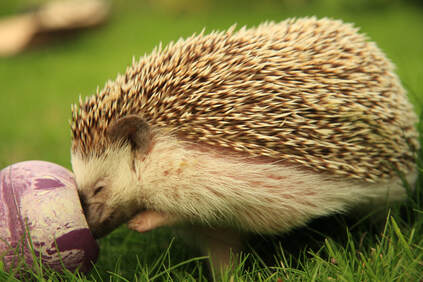
The most important piece of enrichment a hedgehog needs is a 12 inch exercise wheel. Hedgehogs can run miles each night and it is also a great way of helping stopping a hedgie getting overweight. Hoglets should only be given a wheel when they are over 12 weeks old as their muscles and bones are developing and it may cause health problems. A wheel smaller than 12 inches can cause back problems. The wheel needs to have a solid base and sides like the silent spinner, savic or carolina storm wheels.
Good toys for hedgehogs are toilet roll tubes (cut lengthwise so they do not get stuck), kongs (I put a few treats inside and they spend ages trying to get them out), cat toys (without external bells), balls and cuddly toys. Hedgehogs also love to explore tunnels, so cardboard chubes or fabric tunnels are very good as well.
Good toys for hedgehogs are toilet roll tubes (cut lengthwise so they do not get stuck), kongs (I put a few treats inside and they spend ages trying to get them out), cat toys (without external bells), balls and cuddly toys. Hedgehogs also love to explore tunnels, so cardboard chubes or fabric tunnels are very good as well.
- Handling -
To have a well socialised, friendly hedgehog, daily handling is essential. I would say a minimum of 30min to an hour of interaction per day. The hedgehog will also appreciate exercise time in a playpen. Many use ball pools which can be folded up and wiped clean, or indoor rabbit/guinea pig runs. Handling in the evening may be best initially at least as the hedgie will want to come out rather than sleeping.
I find that, at the start, your hands are much more sensitive to the quills, but over time you get used to it. The best way is to wake the hedgehog up, let them go to the toilet before picking up, the scoop them up from underneath. With a calm hedgehog you will just be holding the fur and the spines will be laid flat so they will not prickle. A more timid, sleepy or new hedgehog will most likely ball up with all the quills sticking in different directions. They may also “huff” (this sounds like a steam engine) click and pop. A scared hedgehog will also jump – pushing the spines towards you as a defence against predators. The key is persistence: if possible pick the hedgehog up even when in a ball or huffing and play with them, ignoring any bad behaviour. If the hedgie is particularly prickly, then you can use an old t-shirt (something with your smell on) to pick them up. Even the grumpiest hedgehogs will often come round in the end.
Hedgehogs rarely bite but, if they do, do not return the hedgehog to its enclosure as this enforces the bite as a way of getting put back. They will bite again to get their way. Ignore the bite and carry on handling, giving treats while handling will make sure that the hedgehog associates you with good things and hopefully they will soon be asking to come out.
I find that, at the start, your hands are much more sensitive to the quills, but over time you get used to it. The best way is to wake the hedgehog up, let them go to the toilet before picking up, the scoop them up from underneath. With a calm hedgehog you will just be holding the fur and the spines will be laid flat so they will not prickle. A more timid, sleepy or new hedgehog will most likely ball up with all the quills sticking in different directions. They may also “huff” (this sounds like a steam engine) click and pop. A scared hedgehog will also jump – pushing the spines towards you as a defence against predators. The key is persistence: if possible pick the hedgehog up even when in a ball or huffing and play with them, ignoring any bad behaviour. If the hedgie is particularly prickly, then you can use an old t-shirt (something with your smell on) to pick them up. Even the grumpiest hedgehogs will often come round in the end.
Hedgehogs rarely bite but, if they do, do not return the hedgehog to its enclosure as this enforces the bite as a way of getting put back. They will bite again to get their way. Ignore the bite and carry on handling, giving treats while handling will make sure that the hedgehog associates you with good things and hopefully they will soon be asking to come out.
- Behaviour -
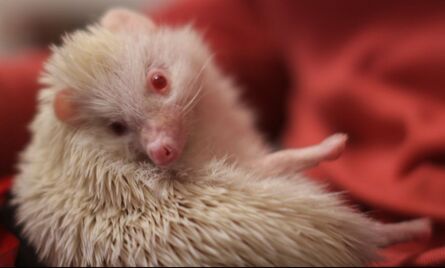
One of the strangest things you will see a hedgehog do is self annointing. This is where the hedgehog will chew and tug at something (sometimes edible and sometimes not) and work up a froth in their mouth. The hedgie will then twist round and lick the spines, spreading the froth over them. They can get into some very strange and surprising positions when doing this and often pull silly faces.
It is not really known why hedgehogs annoint. Some believe it may be a way of disguising their scent to blend in with surroundings, others say it may just be that they like the new smell or taste and spread it all over.
It is not really known why hedgehogs annoint. Some believe it may be a way of disguising their scent to blend in with surroundings, others say it may just be that they like the new smell or taste and spread it all over.
